
a web page by Don Roberson |
 |
||||||
PIPITS & WAGTAILS Motacillidae |
||||||
|
||||||
The widespread species in North America is American Pipit (above and left), often called "Buff-bellied Pipit" in Old World literature. It is quite a different bird in habitat during the summer, when it breeds in alpine meadows above treeline (above) from Alaska to the Rocky Mountains and Sierra Nevada. It also breeds on the arctic tundra, and there is a race (japonicus) that nests in northeast Asia. In winter, though, flocks of American Pipits descend into the lowlands of temperate North America and Asia, where they forage in grasslands, ag fields, and shorelines. In winter plumage (left) they are much less contrasty in pattern. Most of the remaining members of Motacillidae are Old World wagtails in genus Motacilla (13 species), such as African Pied Wagtail, widespread in sub-Saharan Africa, as well as the Nile River valley (below; this individual in body molt with fresh black feathers replacing worn now-brown feathers). A very strange endemic species, quite unlike other wagtails but genetically embedded within genus Motacilla, is the remote and rare Sao Tome Short-tail M. bocagii in southernmost forests of São Tomé Island. |
||||||
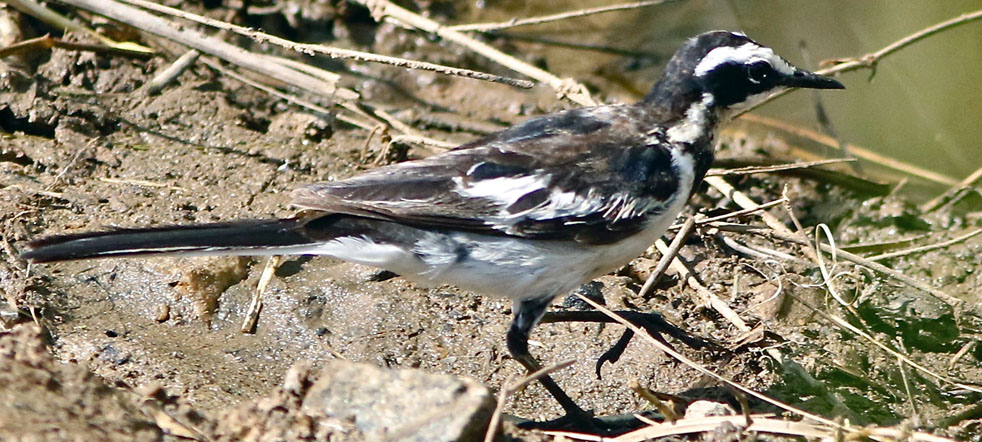 |
||||||
 Those members of the Motacillidae called wagtails include 12 species in the genus Motacilla, and Forest Wagtail Dendronanthus indicus of the eastern Palearctic. About half of these wagtails are long-distance migrants but others, like Mountain Wagtail (right) of the African tropics, are mostly resident birds. Mountain Wagtail, and a fair number of other wagtails, are long-tailed motacilids adapted for feeding along rushing streams, surging rivers, or other wetlands. Over half of the world's wagtails are crisply patterned in black, white, and grays, making for striking patterns among the river-edge boulders. These include the recently discovered Mekong Wagtail M. samveasnae of southeast Asia (Duckworth et al. 2001). There are "river wagtails" that are patterned in black, white, and yellow, such as the widespread Gray Wagtail M. cinerea of the Old World. It is often found along rushing torrents and, like some of the species shown here, is proportionately long-tailed. Gray Wagtail, as do many wagtails and pipits, bobs its tails as it walks. Those members of the Motacillidae called wagtails include 12 species in the genus Motacilla, and Forest Wagtail Dendronanthus indicus of the eastern Palearctic. About half of these wagtails are long-distance migrants but others, like Mountain Wagtail (right) of the African tropics, are mostly resident birds. Mountain Wagtail, and a fair number of other wagtails, are long-tailed motacilids adapted for feeding along rushing streams, surging rivers, or other wetlands. Over half of the world's wagtails are crisply patterned in black, white, and grays, making for striking patterns among the river-edge boulders. These include the recently discovered Mekong Wagtail M. samveasnae of southeast Asia (Duckworth et al. 2001). There are "river wagtails" that are patterned in black, white, and yellow, such as the widespread Gray Wagtail M. cinerea of the Old World. It is often found along rushing torrents and, like some of the species shown here, is proportionately long-tailed. Gray Wagtail, as do many wagtails and pipits, bobs its tails as it walks. |
||||||
 Those wagtails and pipits breeding at high latitudes are very migratory, and because they have long migration routes, mistaken trajectories by individual birds can spin off vagrants. Citrine Wagtail (left) is one of the long-distance migrants in the Old World, with an occasional exceptional vagrant that has turned up in the New World. Those wagtails and pipits breeding at high latitudes are very migratory, and because they have long migration routes, mistaken trajectories by individual birds can spin off vagrants. Citrine Wagtail (left) is one of the long-distance migrants in the Old World, with an occasional exceptional vagrant that has turned up in the New World.Some birds can present significant identification challenges, and some have been controversial [see my "Monterey wagtails" page, created some years ago, for examples]. Taxonomy in wagtails had been in flux for some years. The AOU (1998), for example, considered Black-backed Wagtail "M. lugens" of northeast Asia to be a different species than the rest of the White Wagtail M. alba complex. Molecular evidence presented by Alström & Mild (2003) did not support this split; in due course the AOU relegated lugens to a race of M. alba. However, evidence discussed in Alström & Mild (2003) suggested that there are two biological species of Yellow Wagtail: Western Yellow-Wagtail M. flava (including subspecies flavissima, flava, beema, thunbergi, iberiae, cinereocapilla, pygmae, feldegg, lutea and leucocephala) and Eastern Yellow-Wagtail M. tschutschensis (including subspecies tschutschensis, taivana and macronyx). Under a phylogenetic species concept, such evidence could support ten (!) "species" in the Yellow Wagtail complex, many of them unrecognizable except as adult males. Fortunately, the split into two species of Yellow Wagtail, supported under the biological species concept, has now been widely accepted by global and regional checklists. |
||||||
|
||||||
American Pipit (at top of this page) is the widespread pipit in North America. The other breeding pipit is Sprague's Pipit (left) of the northern prairie grasslands in the interior of North America, generally shy and retiring but giving song-flights on the breeding grounds. This young bird was a rare vagrant to Death Valley, California. In an age before digital photography and big lenses, I was able to get this shot by crawling on my belly on a golf-course where it was feeding. |
||||||
|
||||||
|
||||||
Together, the pipits, wagtails, and longclaws present an interesting and challenging group. For a long time is was uncertain just where the Motacillidae fit in the grand scheme of bird families. Sibley & Ahlquist (1990), using early biochemical evidence, suggested they were closest to sparrows and weavers. That is basically where they've ended up taxonomically. Back then, though, no one would have guessed that the endemic Sao Tome Short-tail Motacilla bocagii, off the coast of central Africa, and the very unusual Madanga Madanga ruficollis of montane forest on Buru in the Southern Moluccas of Indonesia — and was once thought to be an odd white-eye — would to motacillids. As a birder, pipits and wagtails have a habit of flying off or bob-tailing their walk away from the observer, leaving one puzzled, but engaged, by these enigmatic birds. |
||||||
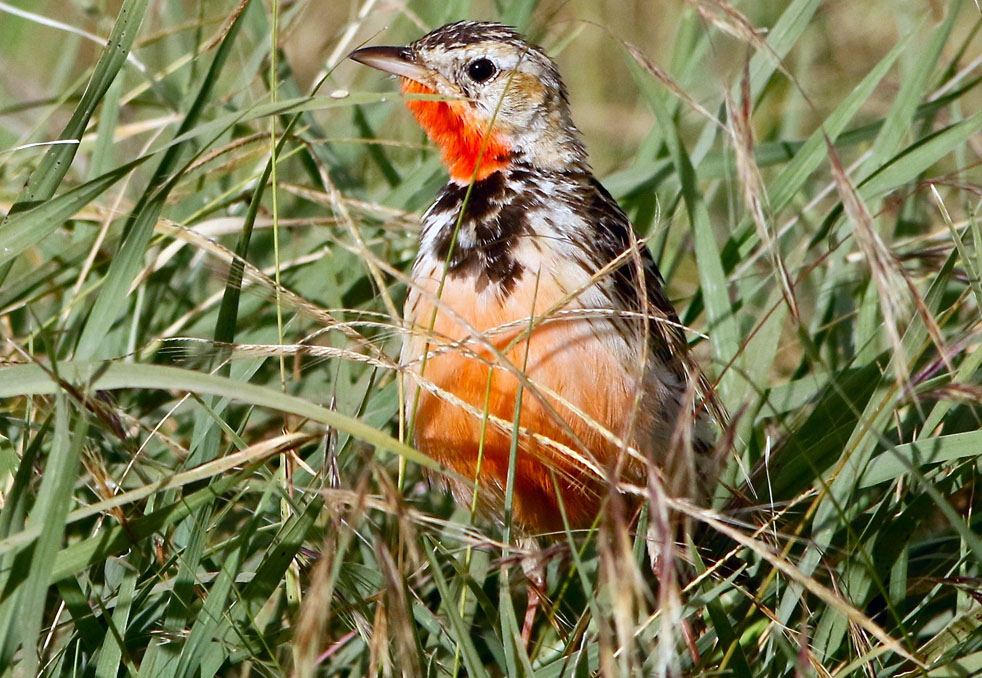 |
||||||
Photos: The American Pipit Anthus rubescens on its breeding grounds was on Hershey Mt., Alaska, on 8 July 2011; the wintering individual was at Moss Landing on 12 Dec 2015. The African Pied Wagtail Motacilla aguimp was at Mkomazi, Tanzania, on 6 June 2018. The Mountain Wagtail Motacilla clara was sunlighted over a dark river at Naro Maro on Mt. Kenya, Kenya, on 11 Nov 1981. The Citrine Wagtail Motacilla citreola was at Guwahati, Assam, India, in 15 Mar 2019. The European race of White Wagtail Motacilla alba alba was at Oslo, Norway, on 26 June 2013; the migrant M.a.alba was at Sharm-el-sheik, Sinai Peninsula, on 7 Nov 1981. The eastern races of White Wagtail are leucopsis in breeding plumage and alboides in breeding plumage, both on migration, along the Paro Chu River, Bhutan, on 2 Apr 2019; the migrant lugens was a vagrant at Santa Cruz, CA, USA, on 22 Nov 1920. The vagrant Sprague's Pipit Anthus spragueii was at Furnace Creek Ranch, Death Valley NP, California, on 11 Oct 1997. The Red-throated Pipit Anthus cervinus and the Tree Pipit Anthus trivialis were migrants at Sharm-el-sheik, on the tip of the Sinai Peninsula, on 7 Nov 1981. The Richard's Pipit Anthus richardi was at Pak Thule, Thailand, on 22 Dec 2012. The Tawny Pipit Anthus campestris was in Desert NP, Rajasthan, India, or 28 Mar 2001. The African Pipit Anthus cinnamomeus was at Angikaret, Tanzania, in 7 June 2018. The Australasian Pipit Anthus novaeseelandiae was panting along the Birdsville track, South Australia, on 20 Nov 2009. The Yellowish Pipit Anthus aguimp was at Emas NP, Brazil, in 28 July 2010. The Yellow-throated Longclaw Macronyx croceus was in Masai Mara NP, Kenya, in Nov 1981. The Rosy-throated Longclaw Macronyx ameliae was in the Ngorongoro Crater, Tanzania, in March 2007. All photos © Don Roberson; all rights reserved. Family book:
For the rest of family as it existed in 2004, see a lengthy introduction, with some excellent photos, in Tyler (2004). Even that compilation, though, will be missing Sao Tome Short-tail and Madanga. Literature cited:
|
 The Motacillidae is a reasonably large family of (mostly) ground feeding birds found throughout open country across the globe. They occur from desert grasslands to alpine meadows to remote oceanic islands (e.g., South Georgia). About two-thirds of the species are pipits in the genus Anthus (42 per recent Clements checklist). Many are widespread Old World species, but there are Anthus pipits in South American grasslands at various elevations, and endemic species at such far-flung locales as South Georgia I. [South Georgia Pipit A. antarcticus] and the Sokoke Forest in coastal Kenya [Sokoke Pipit A. sokokensis].
The Motacillidae is a reasonably large family of (mostly) ground feeding birds found throughout open country across the globe. They occur from desert grasslands to alpine meadows to remote oceanic islands (e.g., South Georgia). About two-thirds of the species are pipits in the genus Anthus (42 per recent Clements checklist). Many are widespread Old World species, but there are Anthus pipits in South American grasslands at various elevations, and endemic species at such far-flung locales as South Georgia I. [South Georgia Pipit A. antarcticus] and the Sokoke Forest in coastal Kenya [Sokoke Pipit A. sokokensis].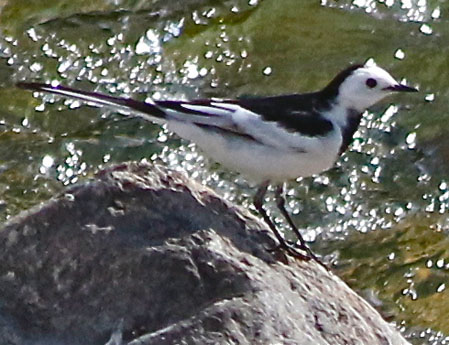


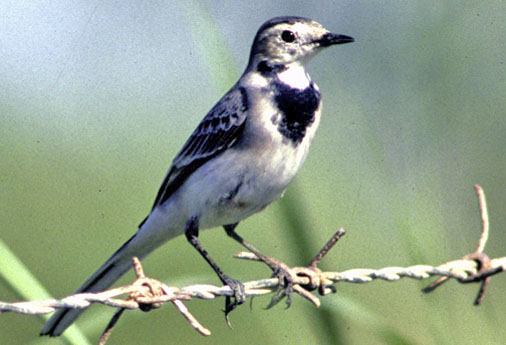

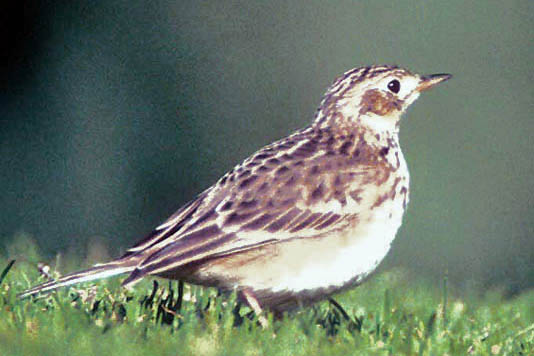
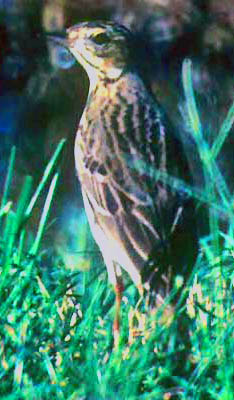

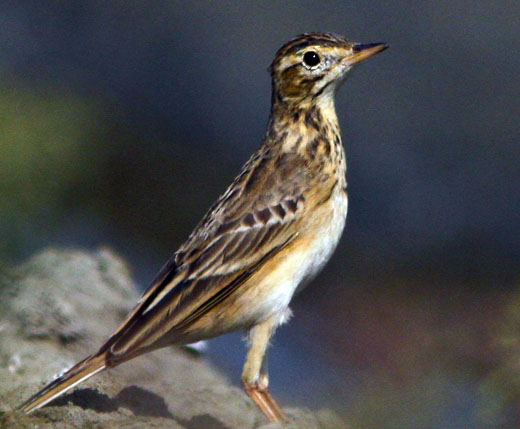

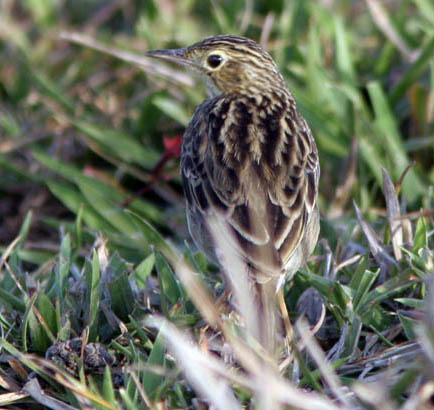

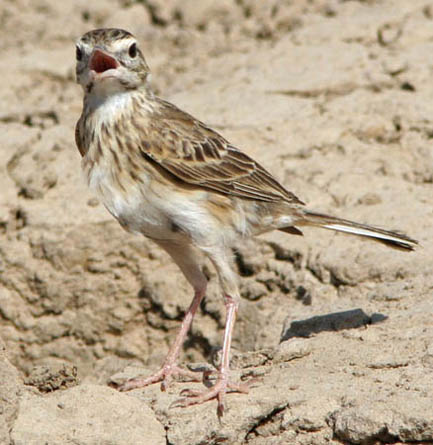
 The final group of motacilids in the family are seven species of Macronyx longclaws, a longclaw and a pipit in genus Hemimacronyx, and the closely related Golden Pipit Tmetothylacus tenellus. These are all grassland species of eastern and southern African. The best known is Yellow-throated Longclaw (right), resident in grasslands south of the Sahara and celebrated in books and museums for its resemblance to North America meadowlarks, which are completely unrelated icterids. Longclaws and meadowlarks illustrate a textbook case of convergent evolution. Other longclaws have limited distribution and frequent Brachystegia woodlands (e.g., Fuelleborn's M. fuellebornii) or montane grasslands (e.g., Abyssinian M. flavicollis, endemic to Ethiopia). Rosy-throated Longclaw (below) is very locally distributed in wet grasslands or seasonal floodplains, where it is generally shy and inconspicuous, despite its obvious beauty. It might be the most colorful motacillid.
The final group of motacilids in the family are seven species of Macronyx longclaws, a longclaw and a pipit in genus Hemimacronyx, and the closely related Golden Pipit Tmetothylacus tenellus. These are all grassland species of eastern and southern African. The best known is Yellow-throated Longclaw (right), resident in grasslands south of the Sahara and celebrated in books and museums for its resemblance to North America meadowlarks, which are completely unrelated icterids. Longclaws and meadowlarks illustrate a textbook case of convergent evolution. Other longclaws have limited distribution and frequent Brachystegia woodlands (e.g., Fuelleborn's M. fuellebornii) or montane grasslands (e.g., Abyssinian M. flavicollis, endemic to Ethiopia). Rosy-throated Longclaw (below) is very locally distributed in wet grasslands or seasonal floodplains, where it is generally shy and inconspicuous, despite its obvious beauty. It might be the most colorful motacillid.